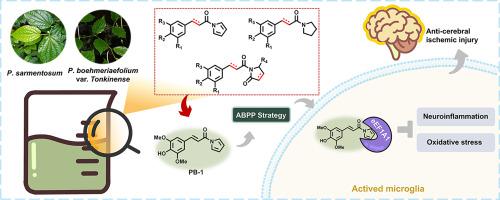当前位置:
X-MOL 学术
›
Phytomedicine
›
论文详情
Our official English website, www.x-mol.net, welcomes your
feedback! (Note: you will need to create a separate account there.)
N-Cinnamoylpyrrole-derived alkaloids from the genus Piper as promising agents for ischemic stroke by targeting eEF1A1
Phytomedicine ( IF 6.7 ) Pub Date : 2024-02-14 , DOI: 10.1016/j.phymed.2024.155455 Baojun Su 1 , Gaowu Huang 1 , Shanshan Zhu 1 , Yaqi Wang 1 , Qian Lan 1 , Yue Hou 2 , Dong Liang 1
Phytomedicine ( IF 6.7 ) Pub Date : 2024-02-14 , DOI: 10.1016/j.phymed.2024.155455 Baojun Su 1 , Gaowu Huang 1 , Shanshan Zhu 1 , Yaqi Wang 1 , Qian Lan 1 , Yue Hou 2 , Dong Liang 1
Affiliation

|
Ischemic stroke (IS) is a serious cerebrovascular disease characterized by significantly elevated mortality and disability rates, and the treatments available for this disease are limited. Neuroinflammation and oxidative stress are deemed the major causes of cerebral ischemic injury. -Cinnamoylpyrrole alkaloids form a small group of natural products from the genus and have not been extensively analyzed pharmacologically. Thus, identifying the effect and mechanism of cinnamoylpyrrole-derived alkaloids on IS is worthwhile. The present research aimed to explore the antineuroinflammatory and antioxidative stress effects of -cinnamoylpyrrole-derived alkaloids isolated from the genus and to explain the effects and mechanism on IS. -cinnamoylpyrrole-derived alkaloids were isolated from var. and and identified by various chromatographic methods. Lipopolysaccharide (LPS)-induced BV-2 microglia and a mouse model intracerebroventricularly injected with LPS were used to evaluate the antineuroinflammatory and antioxidative stress effects. Oxygen‒glucose deprivation/reperfusion (OGD/R) and transient middle cerebral artery occlusion (tMCAO) models were used to evaluate the effect of on IS. To elucidate the fundamental mechanism, the functional target of was identified by affinity-based protein profiling (ABPP) strategy and verified by cellular thermal shift assay (CETSA), drug affinity responsive target stability (DARTS), and circular dichroism (CD) analyses. The effect of on the NF-κB and NRF2 signaling pathways was subsequently evaluated via western blotting and immunofluorescence staining. The results showed that cinnamoylpyrrole-derived alkaloids significantly affected neuroinflammation and oxidative stress. The representative compound, not only inhibited neuroinflammation and oxidative stress induced by LPS or OGD/R insult, but also alleviated cerebral ischemic injury induced by tMCAO. Further molecular mechanism research found that promoted antineuroinflammatory and antioxidative stress activities via the NF-κB and NRF2 signaling pathways by targeting eEF1A1. Our research initially unveiled that the therapeutic impact of on cerebral ischemic injury might rely on its ability to target eEF1A1, leading to antineuroinflammatory and antioxidative stress effects. The novel discovery highlights eEF1A1 as a potential target for IS treatment and shows that , as a lead compound that targets eEF1A1, may be a promising therapeutic agent for IS.
中文翻译:

N-肉桂酰吡咯衍生的胡椒属生物碱通过靶向 eEF1A1 作为治疗缺血性中风的有希望的药物
缺血性脑卒中(IS)是一种严重的脑血管疾病,其特征是死亡率和致残率显着升高,并且该疾病的治疗方法有限。神经炎症和氧化应激被认为是脑缺血损伤的主要原因。 -肉桂酰吡咯生物碱是该属的一小类天然产物,尚未进行广泛的药理学分析。因此,确定肉桂酰吡咯衍生生物碱对 IS 的影响和机制是值得的。本研究旨在探讨从该属中分离的α-肉桂酰吡咯衍生生物碱的抗神经炎症和抗氧化应激作用,并解释其对IS的作用和机制。从 var. 中分离出源自肉桂酰吡咯的生物碱。并通过各种色谱方法进行鉴定。采用脂多糖(LPS)诱导的 BV-2 小胶质细胞和脑室内注射 LPS 的小鼠模型来评估抗神经炎症和抗氧化应激作用。采用氧糖剥夺/再灌注(OGD/R)和短暂性大脑中动脉闭塞(tMCAO)模型来评估对IS的影响。为了阐明其基本机制,通过基于亲和力的蛋白质分析(ABPP)策略鉴定了功能靶点,并通过细胞热位移测定(CETSA)、药物亲和力响应靶点稳定性(DARTS)和圆二色性(CD)分析进行验证。随后通过蛋白质印迹和免疫荧光染色评估对 NF-κB 和 NRF2 信号通路的影响。结果表明,肉桂酰吡咯衍生的生物碱显着影响神经炎症和氧化应激。 该代表性化合物不仅能抑制LPS或OGD/R损伤引起的神经炎症和氧化应激,还能减轻tMCAO引起的脑缺血损伤。进一步的分子机制研究发现,通过靶向eEF1A1,通过NF-κB和NRF2信号通路促进抗神经炎症和抗氧化应激活性。我们的研究最初揭示,对脑缺血损伤的治疗作用可能依赖于其靶向 eEF1A1 的能力,从而产生抗神经炎症和抗氧化应激作用。这一新发现凸显了 eEF1A1 作为 IS 治疗的潜在靶点,并表明,作为靶向 eEF1A1 的先导化合物,可能是一种有前途的 IS 治疗剂。
更新日期:2024-02-14
中文翻译:

N-肉桂酰吡咯衍生的胡椒属生物碱通过靶向 eEF1A1 作为治疗缺血性中风的有希望的药物
缺血性脑卒中(IS)是一种严重的脑血管疾病,其特征是死亡率和致残率显着升高,并且该疾病的治疗方法有限。神经炎症和氧化应激被认为是脑缺血损伤的主要原因。 -肉桂酰吡咯生物碱是该属的一小类天然产物,尚未进行广泛的药理学分析。因此,确定肉桂酰吡咯衍生生物碱对 IS 的影响和机制是值得的。本研究旨在探讨从该属中分离的α-肉桂酰吡咯衍生生物碱的抗神经炎症和抗氧化应激作用,并解释其对IS的作用和机制。从 var. 中分离出源自肉桂酰吡咯的生物碱。并通过各种色谱方法进行鉴定。采用脂多糖(LPS)诱导的 BV-2 小胶质细胞和脑室内注射 LPS 的小鼠模型来评估抗神经炎症和抗氧化应激作用。采用氧糖剥夺/再灌注(OGD/R)和短暂性大脑中动脉闭塞(tMCAO)模型来评估对IS的影响。为了阐明其基本机制,通过基于亲和力的蛋白质分析(ABPP)策略鉴定了功能靶点,并通过细胞热位移测定(CETSA)、药物亲和力响应靶点稳定性(DARTS)和圆二色性(CD)分析进行验证。随后通过蛋白质印迹和免疫荧光染色评估对 NF-κB 和 NRF2 信号通路的影响。结果表明,肉桂酰吡咯衍生的生物碱显着影响神经炎症和氧化应激。 该代表性化合物不仅能抑制LPS或OGD/R损伤引起的神经炎症和氧化应激,还能减轻tMCAO引起的脑缺血损伤。进一步的分子机制研究发现,通过靶向eEF1A1,通过NF-κB和NRF2信号通路促进抗神经炎症和抗氧化应激活性。我们的研究最初揭示,对脑缺血损伤的治疗作用可能依赖于其靶向 eEF1A1 的能力,从而产生抗神经炎症和抗氧化应激作用。这一新发现凸显了 eEF1A1 作为 IS 治疗的潜在靶点,并表明,作为靶向 eEF1A1 的先导化合物,可能是一种有前途的 IS 治疗剂。































 京公网安备 11010802027423号
京公网安备 11010802027423号